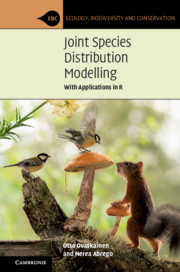4 results
3 - Typical Statistical Methods Applied by Community Ecologists
- from Part I - Introduction to Community Ecology
-
- Book:
- Joint Species Distribution Modelling
- Published online:
- 18 May 2020
- Print publication:
- 11 June 2020, pp 30-38
-
- Chapter
- Export citation
7 - Joint Species Distribution Modelling
- from Part II - Building a Joint Species Distribution Model Step by Step
-
- Book:
- Joint Species Distribution Modelling
- Published online:
- 18 May 2020
- Print publication:
- 11 June 2020, pp 142-183
-
- Chapter
- Export citation
6 - Joint Species Distribution Modelling
- from Part II - Building a Joint Species Distribution Model Step by Step
-
- Book:
- Joint Species Distribution Modelling
- Published online:
- 18 May 2020
- Print publication:
- 11 June 2020, pp 104-141
-
- Chapter
- Export citation

Joint Species Distribution Modelling
- With Applications in R
-
- Published online:
- 18 May 2020
- Print publication:
- 11 June 2020

